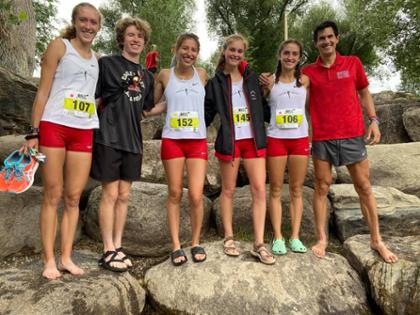Before the sun rises over Georgia’s Springer Mountain at the southern trailhead of the Appalachian Trail, history teacher Charlie Janssen (BSEd ‘12) will set out on a quest to become the 13th person to complete the AT, the Pacific Crest Trail, and the Continental Divide Trail, consecutively, in 365 days.
Total length of the AT: 2,190 miles across 14 states, from Georgia to Maine.
Total length of the PCT: 2,650 miles from Mexico to Canada through California, Oregon, and Washington.
Total length of the CDT: 3,100 miles between Mexico and Canada, across five states along the spine of the Rocky Mountains.
Combined, that’s 7,940 miles.
He’ll be carrying a carefully curated set of 45 items in a Hyperlite Junction backpack, for a total weight of 22.28 pounds. He’ll be going alone, but he’ll take along something from his days on campus.
“The mental fortitude I learned as a Pitt State athlete – that tenacity – is something I will take with me on the trail,” he said.
Janssen, who described himself “as an average athlete at Pitt State,” was coached by legendary coach Russ Jewett, who retired last year.
“I trained like an Olympian, but I raced like a high schooler,” Janssen said. “It finally got pieced together when I was a senior.”

Charlie (fourth from right) his senior year at Pitt State
In the last nine years, Janssen has pursued his goal of becoming a high school history teacher as well as a cross country and track coach himself.
He first taught history and coached at Girard High School, then moved west to teach and coach in Russell, Kansas, and still further west to teach and coach in Gypsum, Colorado, until the end of the Fall 2021 semester when he decided to take a sabbatical to attempt this feat.

Charlie (right) with a few of his student athletes after a meet in Colorado in 2020
“I feel like I’m psychologically and physically capable and ready for it,” he said, “and I feel like I’m also, in a way, representing kids I’ve coached in three districts.”
Starting out
Janssen grew up in Leawood, Kansas, where he would take breaks from the big city to backpack at Philmont Scout Ranch in New Mexico and float the famed rivers of Southern Missouri.
He came to Pittsburg State in Fall 2006, where he became part of a tight nucleus of runners and began exploring degree and career options.
He started his first thru hike on the AT in July 2012, two months after graduation.
“It was a humbling experience,” he said. “I had super heavy gear, I weighed 156 pounds and my pack was one-third of that, and I ran into a major health issue that took me off the trail for 16.5 days — and I was in the ICU for five of them,” he said.
Determined to continue, and raising money for a scholarship fund for children in poverty in Appalachia, he got back on the trail and found himself in a Halloween snowstorm in Tennessee.
“For 300 miles, I was in waist-deep snow,” he said. “Of the 359 others who started the trail southbound, 29 finished."
It took him 103 days; his goal had been 100.
And while it was filled with adversity, it also “washed my spirit clean,” he said.
In 2013, he began to dream bigger.
“That’s when I began to think that achieving the North American ‘Triple Crown’ of long-distance hiking (AT, PCT, CDT) in one year was actually attainable,” he said.
Planning
For nine years, he has trained and schemed. He checked the Colorado Trail, the Leadville 100, and Tour de Mont Blanc in Italy, France, and Switzerland off his list — the latter of which he did with his wife, whom he married in 2019.
For the past two years, he’s studied, mapped, planned, trained and schemed some more.
Logistics are one of the most challenging — and important — parts of long-distance hiking, he said.
“You have to figure out things like the best cell phone, from battery economy to photo resolution,” he said. “You have to figure out permits, which for the PCT involves a lottery system, and you have to start on the day the permit says. Barring that, you have to acquire 20 different permits — seven of them at little kiosks in the woods on the trail. There isn’t much room for error.”
Hikers also must be warm enough, cool enough, equipped enough, and yet light enough to make good miles.
“You have to shave off grams,” he said. “My goal is to do this unsupported; in other words, self-sustained, carrying my gear at all times.”
Giving
Because he’s a believer in both preservation, having been inspired by John Muir, and conservation, having been inspired by Theodore Roosevelt and Gifford Pinchot, he chose to use his Triple Crown attempt as a fundraiser for the National Wildlife Federation.
“Their vision, mission, and goals really struck a chord in me as an educator, wildlife junkie, and endurance athlete,” he said.
To that end, he has established a Linktree that includes a contribution page, gear lists and his Garmin GPS data.
He’s spent the past month pouring over maps and blogs, but with only 12 people having achieved it, there’s not a lot of first-hand data. Only one — a person whose trail name is “Legend” — has completed it in the way he’s planning to: straight through, consecutively, not skipping around and doing various sections of each of the trails according to weather.
“But I believe I can do it,” he said. “I learned grit and tenacity running at Pitt State.”
Learn more: